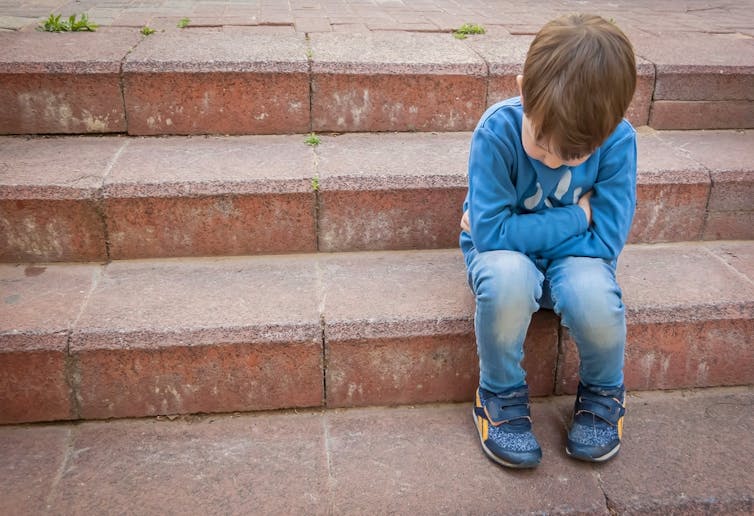Young British people are not seeking help for PTSD
Burden of trauma and PTSD in young British people revealed – new research

Stephanie Lewis, King's College London
For most people, the terms trauma and post-traumatic stress disorder (PTSD) lead to thoughts of veterans haunted by battlefield atrocities. Few realise that children and adolescents can experience trauma and develop PTSD, too. And research suggests that young people may be exposed to the highest rates of trauma, and that many of these go on to develop PTSD.
Trauma includes serious injury, sexual assault and risk of death. These events can be directly experienced or witnessed, or the person can hear about them happening to a loved one.
Immediately after a traumatic event, most people – including children – experience some psychological symptoms, which usually resolve in days to weeks. However, for some, symptoms may be longer lasting and interfere with their daily lives, which indicates it has become a mental health disorder, such as PTSD. People with PTSD experience frequent distressing memories or nightmares about their trauma and avoid upsetting reminders. They also experience guilt, isolation, irritability and often have problems concentrating and sleeping.
To understand the burden of trauma and PTSD in British young people, we carried out the first comprehensive community study of this topic in the UK. We interviewed participants in the E-Risk Study, a sample of over 2,000 young people born in England and Wales in 1994-1995, when they were 18 years old. We asked them about their exposure to traumas, and also assessed their mental health.
First, we considered how common trauma and PTSD are in British young people. We found that nearly one in three had been exposed to trauma by age 18. The most common type of trauma experienced was learning about death, injury, or sexual assault of a loved one. But other trauma types occurred nearly as often, including directly experiencing or witnessing accidents or violence.
We also found that one in 13 had developed PTSD by age 18 – that’s one in four of those exposed to trauma. Young people who had directly experienced violence, such as physical or sexual assaults, were much more likely to develop PTSD (57%) than those exposed to other trauma types, such as direct accidents (13%). These findings are in line with previous US and European studies, and reveal the scale of trauma and PTSD in British young people.
Next, we considered other mental health difficulties experienced by young people who’d been exposed to trauma. We found that trauma-exposed young people were twice as likely as their unexposed peers to experience a range of other mental health disorders, while those who had PTSD were nearly five times as likely as those who hadn’t had PTSD to experience another disorder.
We also found that young people who’d been exposed to trauma, and particularly those with PTSD, were more likely to struggle with their daily activities and to harm themselves compared with peers who hadn’t experienced trauma. Of young people with PTSD, three-quarters had another mental health condition, a quarter were out of education or employment, half had self-harmed and a fifth had attempted suicide.
These findings reveal that trauma-exposed young people often have complex mental health problems. This extends previous research to provide the most comprehensive description to date to guide healthcare professionals in their clinical assessment and treatment of trauma-exposed young people.
Health service use gap
We also considered health service use. Despite their complex difficulties, we found that only a minority of trauma-exposed young people with a mental health disorder had accessed health services. Of those who had PTSD, less than one in three spoke with their GP about their mental health problems, and only one in five saw a mental health specialist in the past year. This is troubling because mental health professionals can provide effective treatments for PTSD and other trauma-related disorders. Sadly, without this treatment, a large proportion of young people with PTSD have persistent symptoms.
Our findings highlight the pressing need to identify and address barriers that prevent trauma-exposed young people from accessing healthcare, so that more of those affected can receive treatment. These barriers might include factors that prevent young people from seeking help, such as stigma and shame, as well as factors that prevent health services from providing the required care, such as a lack of resources.

Identifying those at risk
Given the high mental health needs of some trauma-exposed young people and the difficulties in recognising those at greatest risk, we tested whether known risk factors can be combined to predict a trauma-exposed young person’s risk of developing PTSD. We used modern machine learning techniques (a type of artificial intelligence) to develop and test a PTSD risk calculator in different groups in our sample. We found that our risk calculator accurately predicted PTSD in trauma-exposed participants. The risk calculator now needs to prove its accuracy in different samples, before it can be used in clinical practice.
If a PTSD risk calculator can make accurate predictions in other young people, it could provide a useful tool to help mental health professionals identify trauma-exposed young people at greatest risk of developing PTSD. This would enable healthcare professionals to offer support early on to those with the greatest clinical needs, to prevent the development and progression of PTSD and other trauma-related disorders.![]()
Stephanie Lewis, Clinical Lecturer in Child and Adolescent Psychiatry and MRC Clinical Research Training Fellow, King's College London
This article is republished from The Conversation under a Creative Commons license. Read the original article.







